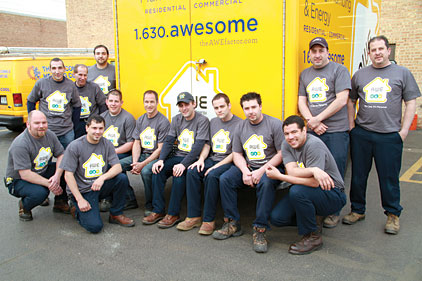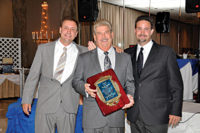
For starters, the one technique everyone recommends avoiding is the hard-selling approach. According to Bala Ekambaram, director of product marketing for IAQ, Honeywell, “Homeowners aren’t looking to be sold. They’re looking for consultation.” He continued, “Being able to act as a consultant, rather than a salesperson, is particularly important when it comes to indoor air quality solutions, which have traditionally been viewed by homeowners as a ‘nice-to-have,’ not a ‘need-to-have.’”
Because people are seeking education and information, contractors who are prepared to educate and advise them are more likely to succeed than those who try more aggressive tactics. “Selling whole-house humidification/dehumidification systems can be done successfully when the consultative approach is used,” Ekambaram said.
THE RIGHT TRAINING
In order to be perceived as a consultant, a contractor must first be well-educated and trained in IAQ and humidity control. “Training is the key,” said Peter L. Blaha, product marketing manager, Aprilaire. “Not only is it crucial to have a strong understanding of the technical aspects of humidification, but it is equally important to know the problems associated with IAQ, how to identify those problems in the home, and most importantly, how to explain these problems to the homeowner and how a contractor can help to solve them.”
Joe Hlavacek, business development manager, Ultra-Aire, added that it is important for contractors to “educate and establish oneself as the expert.” He noted that contractors can “attend training sessions on the technology at a local distributor or call your manufacturer of choice to schedule an in-house training session for you and your team.”
THE RIGHT CONVERSATION
Once trained, contractors should be better prepared to initiate conversations with homeowners that will inform them about possible solutions to humidity and comfort problems. According to Blaha, after a contractor has tested a home for relative humidity, he should follow up by “explaining to the homeowner in detail the problems or potential problems associated with air that is constantly too dry or too humid.”
Then, Blaha continued, “The real opportunity for the contractor comes from being able to explain the benefits of whole-house installed systems.” He added that these benefits include “easier and less frequent maintenance, proper and automatic control, and capacities that fit a variety of sizes of homes and unique applications.” By being willing to listen, teach, and explain, contractors should be able to hold more productive conversations with consumers.
“Having these conversations with homeowners helps establish the contractor as a uniquely qualified IAQ expert; and that translates to sales, repeat business, and referrals,” Blaha said.
John Riley, vice president, sales and marketing, Skuttle Indoor Air Quality Products, added that many prospective clients will “research HVAC science and equipment before they call.” Because of this, he said, “Contractors who listen to these homeowners and converse with them on a technical level are in a better position to gain their trust and respect, not to mention their business.”
Riley continued, “These homeowners want to know what, why, how much, and when.” He said that contractors should offer a complete explanation of tasks to be performed, provide a detailed estimate, submit a quote that includes parts and labor, and — of course — perform as promised.
One contractor who carries Aprilaire products shared how he successfully consults with consumers about IAQ to sell Aprilaire humidifiers. Ray Grimm, CEO of A.W.E. – Air Water Energy (Carol Stream, Ill.) said, “Talk to them about indoor air quality; let them know how the humidifier works. Do a good job and let them know the benefits. Let them know that this is a quality product, and this is what we give them when we come into their home for the solution.”
Grimm continued, “Sure, it takes more time with a client. You have to explain the benefits of what that air cleaner, or humidification, or dehumidifier, is all about. Let’s talk about zoning. Let’s talk about options that are available for the client’s indoor air quality and the comfort that they have. Clients want it. Most do, if you offer it to them.”
THE RIGHT CONTRACTOR
In addition to getting the right training and initiating the right conversations, it’s also important to position yourself as the right contractor for the job. According to Hlavacek, it’s important to differentiate your business. “Sell real solutions not offered by all your competitors. Position yourself as an industry leader by creating a competitive edge with the right product.”
He explained that this means offering professional, energy-efficient products. “Choose whole-house dehumidifiers with superior energy-efficiency and reliability, that aren’t readily available on the Internet. This will allow you to charge more, while protecting your reputation as a solution provider not a price gouger.”
In the end, Hlavacek said, contractors should gain more business by differentiating themselves as a company that provides whole-home comfort solutions. “You can justify a higher price point and increase profits if you are a true solution provider,” he said.
But getting to that point isn’t always easy. It requires time, training, and patience. So don’t just sell that dehumidifier or humidifier — take the time to explain, teach, consult with your potential customer first. It just may be the right approach you need to increase sales.
Sidebar: When Sizing a Humidifier
Information provided by Honeywell
If a humidifier is undersized for a home design, excessive run time, operating cost, and a decrease in comfort are possible. It is important for contractors to account for external home factors to avoid excessive run times, or an inability to hit the humidity control set point.
The following home construction variables should be taken into account to properly size a humidifier for a home:
• Tight homes have vapor retarders, tight storm doors, windows with weather stripping, dampered or no fireplace, and use ½ air change per hour for ventilation.
• Average homes also have vapor retarders and a dampered fireplace, but can have loose fittings on storm doors and high heat-loss windows. They also can have up to 1 air change per hour.
• Loose homes are generally built before 1930 and have not been refurbished. They have little to no insulation, no storm doors, poor windows, no weather stripping, no vapor retarders, no insulated windows, an undampered fireplace, and usually have approximately 1½ air changes per hour for ventilation.
Other variables to consider include, but are not limited to, insulation type, ceiling height throughout the home, control settings, and ventilation sources. Contractors should ask the following questions to determine the effect of these variables.
• Is the insulation of the home tight, average, or loose? A general rule of thumb is that homes built after 1985 are generally average to tight. Homes built before 1985 are generally loose to average, unless they have been remodeled with tighter insulation practices.
• Is the ceiling height throughout the home uniformly held at 8 feet? If there are areas where ceiling heights are higher — such as split-level homes, vaulted ceilings, or great room areas, then the total volume of the space is larger.
• Is the indoor temperature held at higher than average levels? (In this case, average is 68 to 72°F.) Industry load requirement guidelines are based on 72° indoor temperatures. Additionally, does the home have a programmable control with extreme temperature fluctuation? These fluctuations in temperature can affect humidity levels in the home.
• And most importantly, are there sources of intake or exhaust ventilation to consider? These include mechanically occurring ventilation such as a forced air ventilator or naturally occurring ventilation such as open windows, dampers open on fireplaces, or loose insulation.
Looser construction, higher ceiling heights, higher temperatures, and extra ventilation all increase the humidity demands in a home. Carefully considering the factors listed above will ensure properly sized humidifiers and a more comfortable living environment for the homeowner.






